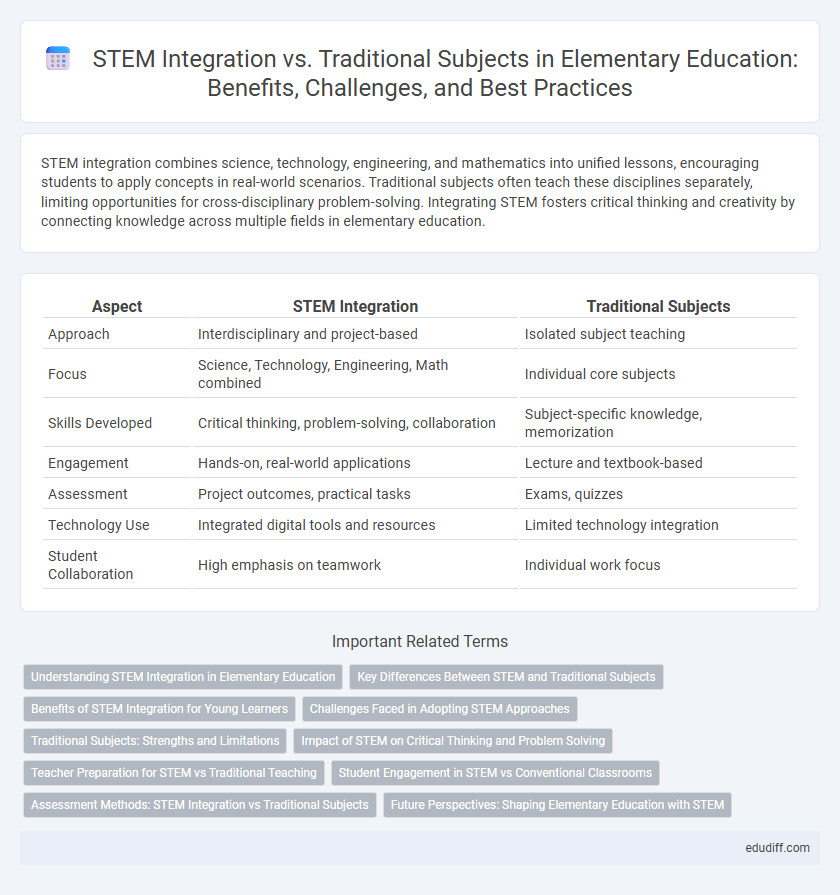STEM integration combines science, technology, engineering, and mathematics into unified lessons, encouraging students to apply concepts in real-world scenarios. Traditional subjects often teach these disciplines separately, limiting opportunities for cross-disciplinary problem-solving. Integrating STEM fosters critical thinking and creativity by connecting knowledge across multiple fields in elementary education.
Table of Comparison
| Aspect | STEM Integration | Traditional Subjects |
|---|---|---|
| Approach | Interdisciplinary and project-based | Isolated subject teaching |
| Focus | Science, Technology, Engineering, Math combined | Individual core subjects |
| Skills Developed | Critical thinking, problem-solving, collaboration | Subject-specific knowledge, memorization |
| Engagement | Hands-on, real-world applications | Lecture and textbook-based |
| Assessment | Project outcomes, practical tasks | Exams, quizzes |
| Technology Use | Integrated digital tools and resources | Limited technology integration |
| Student Collaboration | High emphasis on teamwork | Individual work focus |
Understanding STEM Integration in Elementary Education
STEM integration in elementary education combines science, technology, engineering, and math into cohesive learning experiences, enhancing problem-solving and critical thinking skills. Unlike traditional subjects taught in isolation, STEM integration emphasizes real-world applications and interdisciplinary connections. This approach fosters collaboration and creativity, preparing young students for future academic and career success in a rapidly evolving technological landscape.
Key Differences Between STEM and Traditional Subjects
STEM integration emphasizes interdisciplinary learning by combining science, technology, engineering, and math concepts, fostering critical thinking and real-world problem-solving skills. Traditional subjects often focus on isolated disciplines with memorization and theoretical knowledge. STEM encourages hands-on activities and collaboration, whereas traditional subjects typically rely on lecture-based instruction and individual assessment.
Benefits of STEM Integration for Young Learners
STEM integration enhances critical thinking and problem-solving skills in young learners by connecting science, technology, engineering, and mathematics through real-world applications. Early exposure to interdisciplinary STEM projects fosters creativity and collaboration, preparing students for future academic success and competitive careers. Research shows that students engaged in STEM integration demonstrate higher engagement, motivation, and improved academic outcomes compared to traditional subject learning.
Challenges Faced in Adopting STEM Approaches
Elementary educators face challenges in adopting STEM approaches due to limited resources, insufficient training, and curriculum constraints. Integrating science, technology, engineering, and math requires professional development to build teacher confidence and competence. Balancing STEM activities with traditional subjects often leads to scheduling conflicts and difficulty in meeting standardized testing requirements.
Traditional Subjects: Strengths and Limitations
Traditional subjects in elementary education provide a structured foundation in core areas such as reading, writing, and arithmetic, ensuring essential skills are systematically developed. Their strength lies in clear curricula and standardized assessment methods that offer measurable academic progress. However, their limitations include less emphasis on interdisciplinary connections and practical problem-solving skills that STEM integration promotes.
Impact of STEM on Critical Thinking and Problem Solving
STEM integration in elementary education enhances critical thinking by encouraging students to apply scientific methods and mathematical reasoning to real-world problems. This approach fosters problem-solving skills through hands-on projects and collaborative learning, contrasting with traditional subjects that often emphasize rote memorization. Research shows students engaged in STEM activities demonstrate greater analytical abilities and creativity, preparing them for complex challenges in higher education and future careers.
Teacher Preparation for STEM vs Traditional Teaching
Teacher preparation for STEM education in elementary schools involves specialized training in science, technology, engineering, and mathematics concepts along with hands-on, inquiry-based learning methodologies. In contrast, traditional teacher preparation typically emphasizes foundational subjects like reading, writing, and basic math without integrating interdisciplinary STEM skills. Effective STEM teacher training focuses on developing skills for project-based learning and technology use to foster critical thinking and problem-solving from an early age.
Student Engagement in STEM vs Conventional Classrooms
STEM integration in elementary classrooms boosts student engagement by promoting hands-on, inquiry-based learning that connects science, technology, engineering, and math concepts in real-world contexts. Research shows students in STEM-integrated settings demonstrate higher motivation, creativity, and critical thinking compared to those in traditional classrooms focused on rote memorization and isolated subject instruction. Interactive projects and collaborative problem-solving in STEM education enhance active participation, fostering deeper understanding and sustained interest in learning.
Assessment Methods: STEM Integration vs Traditional Subjects
STEM integration assessment methods emphasize project-based evaluations, hands-on experiments, and real-world problem-solving tasks that gauge critical thinking and collaboration skills. Traditional subjects typically rely on standardized tests, quizzes, and written assignments to measure knowledge retention and individual performance. The shift towards STEM assessments reflects a focus on applied learning and interdisciplinary understanding, contrasting with the content-specific evaluation of conventional education.
Future Perspectives: Shaping Elementary Education with STEM
STEM integration in elementary education fosters critical thinking, problem-solving, and creativity, preparing students for future careers in technology and science fields. Unlike traditional subjects, STEM emphasizes interdisciplinary learning that mirrors real-world challenges, enhancing student engagement and adaptability. Embracing STEM now ensures a workforce skilled in innovation, meeting the demands of rapidly evolving industries.
STEM Integration vs Traditional Subjects Infographic

 edudiff.com
edudiff.com